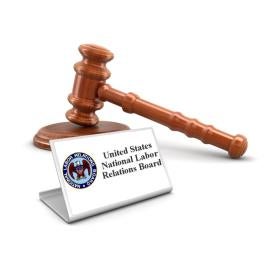INTRODUCTION
On 1 May 2023, the National Labor Relations Board (NLRB or Board) held in Lion Elastomers1 that whether employers violate the National Labor Relations Act (NLRA or Act) when they take adverse employment action against employees who engage in abusive conduct alongside Section 7 activity depends on the setting where such conduct occurred, such as in the workplace, on social media, or along a picket line, than the nature of the conduct or the employer’s motive.
In doing so, the NLRB reversed another Trump-era precedent, which previously held that whether employee abusive conduct lost NLRA protection hinged solely on whether employers harbored an anti-union motive when taking adverse action, regardless of where or when the abusive conduct occurred.
As discussed further below, employers with unionized and nonunionized workforces must again focus on the specific setting of an employee’s abusive conduct before determining whether they may legally take adverse action under the NLRA.
Employees Engaging in Abusive Conduct Now Enjoy Greater Protections
The question in play here is when activity that might otherwise be protected under Section 7 of the Act loses its protection because of the manner in which the activity was conducted. In General Motors,2 the Trump-era NLRB moved away from the Board’s prior precedent by holding that conduct lost any NLRA protection it might have enjoyed if it occurred in an abusive manner, e.g., profanity or epithets.
Specifically, General Motors held that it would apply the NLRB’s longstanding Wright Line3 burden-shifting causation test in any case where an employer claims to have disciplined an employee for engaging in abusive conduct, regardless of the setting in which the conduct occurred. Thus, under General Motors, an employer only violated the NLRA after taking adverse action against an employee for abusive conduct if the employee could show that the employer took such action because it was motivated by animus against the underlying Section 7 activity.
In Lion Elastomers, the Board rejected General Motors as a “sweeping change in Federal labor law” that failed to account for the “policy rationale” undergirding the Board’s setting-specific standards for adjudicating employee abuse cases.4 That rationale was predicated on the Board’s perception that there is a “fundamental difference” between “employee misconduct committed during Section 7 activity and misconduct during ordinary work.” The former, rationalized the Board, will inevitably evoke heightened passions among employees given the nature of labor disputes.5 With that justification, the Lion Elastomers Board restored three setting-specific standards, and will apply them retroactively.
First, and most commonly, employee abusive conduct aimed at employers in the workplace is again governed by the four-factor Atlantic Steel balancing test, which examines “(1) the place of the discussion; (2) the subject matter of the discussion; (3) the nature of the employee’s outburst; and (4) whether the outburst was, in any way, provoked by an employer’s unfair labor practice.”6
Second, employee abusive conduct targeting employers on social media or during coworker discussions will once more be adjudicated under a totality-of-the-circumstances test “without reference to any particular [Atlantic Steel] factors.”7
Third, employee abusive conduct toward employers on picket lines must again be analyzed under Clear Pine Mouldings,8 where the “Board considers whether, under all of the circumstances, non-strikers reasonably would have been coerced or intimidated by the picket-line conduct.”
In restoring these three setting-specific standards, the NLRB in Lion Elastomers held that while they were not “mandated by the Act”, they are “statutorily permitted” and “reflect a better policy choice” than General Motors, which the current Board accused of elevating employer interests over employee rights. The NLRB noted in Lion Elastomers that its choice was buttressed by what “Congress envisioned” because of the Board’s “expertise in labor-management matters” that “the Federal courts would defer” to.
Specifically, the NLRB in Lion Elastomers held that Wright Line gave “too little weight to employees’ statutory rights and too much weight to employers’ interests” by allowing “employers engaged in a labor dispute to determine the scope of their employees’ statutorily protected activity in negotiating a contract, pursuing a grievance, walking the picket line, or discussing workplace issues with coworkers—settings outside the realm of ordinary managerial prerogatives.”
Moreover, the NLRB reasoned that Wright Line would permit employers to use facially neutral motives, such as workplace civility, as smokescreens to retaliate against employee Section 7 activity because it “gives employers dangerous discretionary power over employees whenever they exercise their statutory rights in opposition to the employer’s interests.”9 Rather, the NLRB in Lion Elastomers reasoned that the “proper focus is on the employee’s misconduct (or lack of it) and the predictable effect on the exercise of Section 7 rights if the employer were permitted to discipline or discharge the employee.”
Strikingly, the NLRB pronounced that the NLRA “imposes no obligation on employees to be ‘civil’ in exercising their statutory rights” and that the “Board—not employers—referees the exercise of protected activity under the Act.”
Employer Takeaways when Confronted with Employee Abuse During Section 7 Activity
A principle virtue of General Motors was its simplicity and ease of application by employers. Abusive employee conduct was abusive conduct, and could be disciplined as such, provided employers lacked an anti-union motive in doing so. For example, an employee who used a racial slur at a supervisor could be disciplined per policy or practice, as long as an employer did not previously tolerate such in the workplace.
However, Lion Elastomers changes the equation. It is no longer enough for an employer to say the conduct was abusive, warranted discipline, and that the decision to discipline was not motivated by an anti-union bias. Rather, the employer, prior to taking adverse action against an abusive employee, must analyze the setting in which that activity occurs, determine whether Section 7 rights may be implicated, and apply the appropriate test—Atlantic Steel for workplace abuse, totality-of-the-circumstances for social media and coworker discussions, or Clear Pine Mouldings for picket-line conduct.
Where employee abuse occurs in multiple settings, an employer may need to apply each relevant test accordingly, with special attention paid to which act of abuse—and where it occurred—prompted them to take adverse action. The end result, of course, is that abusive conduct may not be sanctionable conduct in the eyes of the NLRB if it is done alongside Section 7 activity, or at least conduct bad enough to legally warrant discipline. In some respects, the Board’s decision may provide a license for employees to engage in bad behavior when it can be contextualized in terms of a labor dispute over workplace conditions.
It is important to remember that decisions such as Lion Elastomers apply to all employers, not just union employers or employers facing union organizing efforts. In that respect it is notable that Lion Elastomers may leave employers particularly uncertain about what material facts regarding employee abuse on social media or in coworker discussions they should consider, particularly because the NLRB’s jurisprudence in those settings is recent and sparse.10
Employer uncertainty around what type of employee abuse the NLRB may extend protection to on social media under a totality-of-the-circumstances test is especially relevant given the prevalence of remote work more than three years after the outbreak of COVID.
The majority’s blissfully benign characterization of social media in Lion Elastomers as an “an online discussion among employees, where managers are not physically or even virtually present” may hint at a future, employee-friendly NLRB jurisprudence in that setting. Prior NLRB case law should heighten that concern for employers.11
Indeed, given the currently tight labor market and increasing tendency among employees, especially younger employees, to engage in Section 7 activity online—including union organizing—employers should carefully analyze all facts before taking adverse action. For example, employers that tolerate profanity in the workplace may violate the NLRA if they then take adverse action against employees who use profane language toward them on social media.12
Conclusion
The NLRB’s decision in Lion Elastomers marks the latest step by the Board and its Office of General Counsel to overturn Trump-era precedent and reorient federal labor law in a more employee-friendly direction.13 Moreover, it is in keeping with the NLRB General Counsel’s early—and ambitious—goal of determining “whether current law ensures that employees have the right to exercise their fundamental Section 7 rights both fully and freely.”14
One battleground to watch is the U.S. Supreme Court’s recent decision on 1 May 2023 to explicitly reconsider the Chevron doctrine, the spirit of which courts have frequently applied to uphold reasonable agency interpretations of their governing statutes—including the NLRB’s reading of the NLRA.
Should the Supreme Court modify or overturn Chevron, an underpinning of Lion Elastomers–that the Board is entitled to its reasonable interpretation of the NLRA in returning to older jurisprudence establishing setting-specific standards such as Atlantic Steel and Clear Pine Mouldings–could fall by the wayside. In that event, courts may review with fresh eyes whether such setting-specific standards are permissible under the NLRA.15




 i
i


